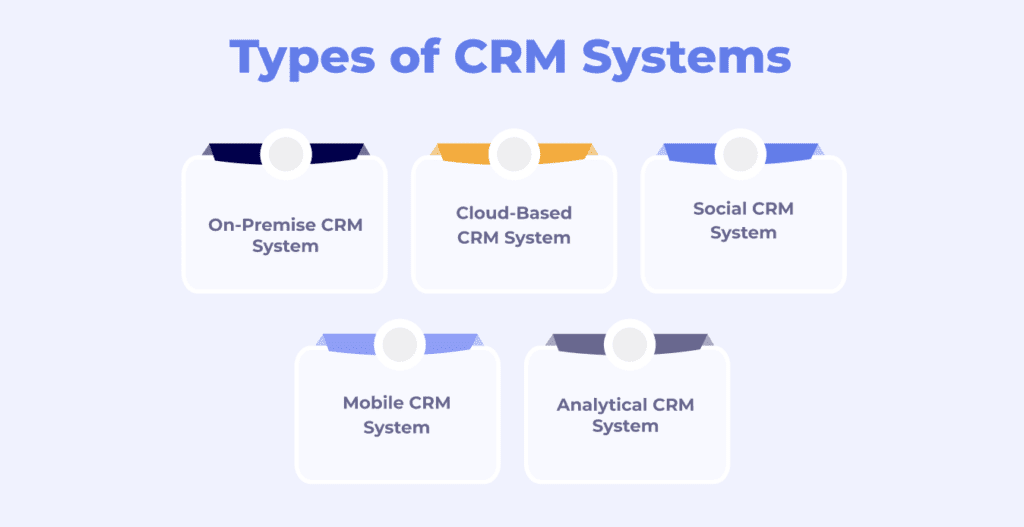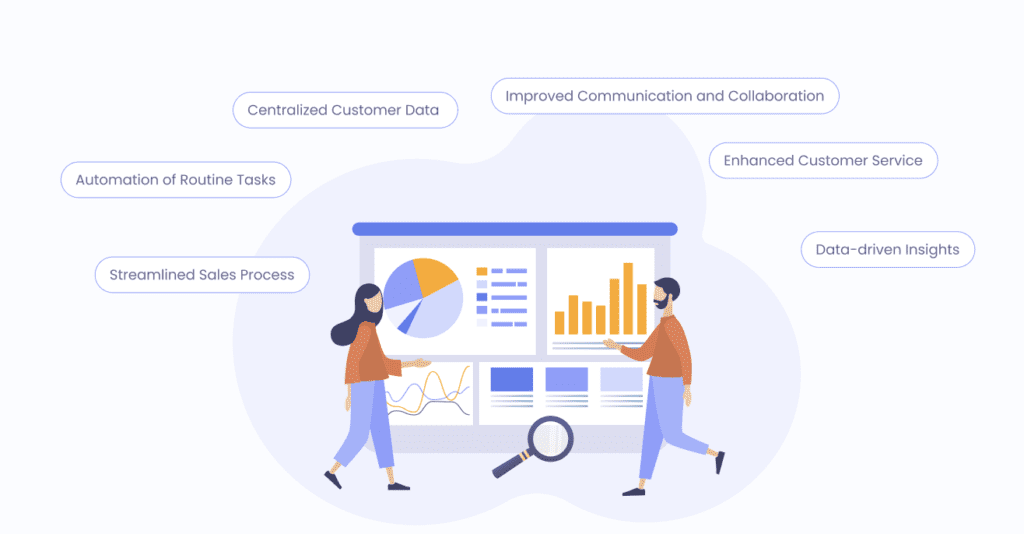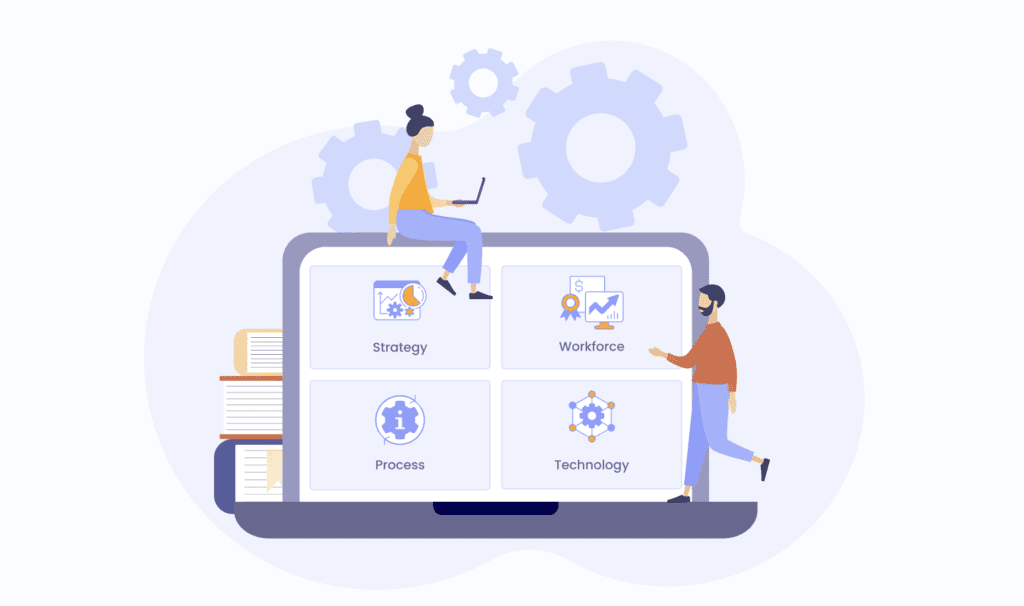Why is Customer Relationship Management (CRM) crucial for growth? How does CRM integrate with other business tools? Confused about CRM’s main pillars for seamless customer control in the US? For me, customers are not just numbers; they are the crown jewels of my company’s fastest-growing asset. I’ve come to realize that in today’s data-driven world, the value of customer information cannot be underestimated.
As my customer base in LA, California grew exponentially, managing customer interactions went from an easy jog to a challenging marathon. My saving grace in this spiraling chaos was a robust CRM system. It’s not just any business tool; it’s a lifeline thrown out on the rough seas of data. It’s the blueprint for my business, allowing me to track customer interactions in detail and develop smart strategies to strengthen customer relationships. The foundation of my thriving customer management is the indispensable component of my chosen CRM system.
Here’s the real truth – in the fast-moving, customer-focused business world, a CRM solution is the heart of business. It not only manages interactions with my existing customers but also nurtures my prospects. In this intricate web of actions and transactions, my CRM system is the glue that holds it all together. It serves as my central hub for managing, storing, and analyzing valuable customer data to help me make smart decisions in real-time.
Join me on a tour of the four main pillars of a CRM system–the very foundation that can turbocharge your business performance. As we reveal the nuances of these pillars, you’ll see how they intertwine to strengthen your business structure for adept customer interactions. Join me on this journey, and together we’ll unlock the true potential of data-driven decision-making.
Definitions
Customer Relationship Management (CRM) System – is a software platform or solution that helps businesses manage and optimize their interactions and relationships with customers. It serves as a centralized database and toolset for storing, organizing, and analyzing customer data to provide valuable insights for effective customer engagement and decision-making.
5 Main Types of CRM Systems


Making informed decisions about implementing a CRM system that meets your business needs is critical. Understanding the differences between the major types of CRM systems can help you navigate the options and choose the one that’s right for you, whether you’re a large enterprise seeking comprehensive control or a small business looking for a simplified, yet effective solution.
On-Premise CRM System
On-premise CRM systems are hosted on the company’s servers and are best suited for larger organizations that have the resources and IT staff to manage the software.
Cloud-Based CRM System
Cloud-based CRM systems are hosted by a third party and are best suited for smaller companies that don’t have the resources to manage their own CRM system.
Social CRM System
Social CRM systems track customers on social media and help businesses interact with and respond to customers in real-time.
Mobile CRM System
Mobile CRM systems provide access to customer data from mobile devices, enabling sales reps and other customer-facing employees to stay connected with customers on the go.
Analytical CRM System
Analytical CRM systems are analytics-driven CRM systems that use data to help understand customer behavior, trends, and market opportunities.
Benefits of Using CRM Systems to Improve Efficiency

CRM systems have a variety of advantages for firms, including increased operational effectiveness and excellent customer experiences. These complete solutions provide organizations looking to better how they manage their client’s data consolidation, easier communication, efficient automated chores, organized sales processes, cutting-edge customer service capabilities, and strong analytics. Businesses that use CRM may see improved productivity, enhanced efficiency, and outstanding customer experiences.
Benefit #1 Centralized Customer Data
CRM systems store all customer-related data in a single, centralized database, including contact information, communication history, purchase history, and customer preferences. Consolidating data about customers makes it easier for teams to access information, eliminating the need to search multiple systems or rely on manual methods. With this accessibility, teams can respond to customer questions and requests more quickly and efficiently.
Benefit #2 Improved Communication and Collaboration
CRM systems provide collaboration and communication capabilities for internal use. Within the CRM system, groups can share customer information, update records, and collaborate on customer-related activities. This reduces the need for back-and-forth emails or searching for information in multiple locations, encouraging better collaboration and eliminating communication delays. CRM makes it easier for teams to work together by simplifying communication.
Benefit #3 Automation of Routine Tasks
In CRM systems, automated data input, task assignment, email responses, and follow-up reminders are regularly accessible capabilities. By automating tedious and repetitive work, CRM frees up crucial time for employees, allowing them to concentrate on more important tasks that need human talent. Operations are accelerated, errors are reduced, and overall effectiveness is raised.
Benefit #4 Streamlined Sales Process
Sales teams can use CRM to manage the entire sales process, from lead creation to deal closure. Features such as pipeline visibility, forecasting, lead tracking, and opportunity management are available. These technologies help sales teams identify bottlenecks in the sales cycle, prioritize leads, and track lead progress. CRM helps sales teams close deals faster, make better-informed decisions, and manage time and resources more effectively by optimizing the sales process.
Benefit #5 Enhanced Customer Service
CRM technologies enable customer service representatives to provide more personalized and effective assistance. Advisors have access to customer data, including details of previous communications and purchases, so they can better tailor their support and address issues. In addition, CRM enables case management, ticket tracking, and customer self-service capabilities that empower users to resolve issues on their own. CRM promotes customer satisfaction while reducing response times by improving the customer service experience.
Benefit #6 Data-driven Insights
CRM systems collect and analyze customer data, providing useful information about customer trends, preferences, and behaviors. With this data, companies are better able to segment their customers and develop effective marketing and product plans. Business processes can be improved, the right audience can be targeted, and resources can be allocated more effectively through the use of data-driven insights.
4 Main Pillars of CRM Systems

The four main pillars of CRM systems – software, the latest technologies, support, and a well-established business – are essential for companies to effectively manage customer relationships. First and foremost, the software serves as the foundation of these systems, enabling data centralization, task automation, streamlined sales processes, and exceptional customer service. By leveraging the latest technologies, companies can improve their performance by analyzing customer data and implementing marketing strategies accordingly. This technology pillar also emphasizes the importance of seamless integration capabilities and mobile access.
However, the magic of the CRM system can only be realized if employees are properly trained and supported. This falls under the support pillar of CRM systems, which focuses on training employees to use the system efficiently and getting top management involved in the process. Finally, the well-established business pillar ties the whole concept of CRM systems together. It emphasizes that it’s impossible to implement successful CRM without having an effective strategy and well-managed processes.
Pillar #1 Workforce
Implementing an effective CRM strategy will be challenging without the workforce’s commitment and productivity, as well as sufficient training on CRM technologies. This is regrettable since the workforce frequently does not receive the same priority as the other CRM system pillars. Despite this, if the remaining pillars are properly put in place, the workforce can start to receive the support and attention it needs. The employees must have the right training to use CRM software efficiently. To adequately train workers on the system, online educational techniques can be employed, such as lectures and documentation. Additionally, top management’s backing is essential for the training process. Management should give employee training and development a top priority to guarantee the adoption of CRM. Effective management skills are also crucial for CRM deployment success.
Pillar #2 Strategy
The most crucial element of a successful business is a comprehensive strategy. To guarantee that any intended consequences are realized, this method must be well-planned. To determine if objectives have been reached, measurement is required. The proper design approach necessitates input from many organizational functions, and CRM software may then deliver precise and trustworthy outcomes. Numerous jobs may be made more effective and simplified thanks to the flexibility of CRM software, and a plan enables the business to better understand both its strengths and shortcomings. The management may allocate duties more successfully by completely comprehending each stage of the procedure with the aid of CRM software. Any organization may put a plan supported by CRM software into practice.
Pillar #3 Process
In business, the process is vital to achieving a goal. Understanding and actively controlling processes are crucial for maximum success, particularly in the context of the Customer Relationship Management (CRM) pillar. Tracking the process should become a regular habit to ensure that it is as successful as possible. Sometimes mistakes and glitches in task analysis can produce pleasantly satisfying results. Thankfully, conducting operations online has become simpler thanks to rapid technological advancement. Employees will get the best outcomes if they learn processes thoroughly and apply them appropriately.
Pillar #4 Technology
Technology integration is crucial to a CRM implementation’s success. The most recent developments provide organizations with the opportunity to access and analyze client data more effectively, as well as deliver better, quicker customer service. Technology-based solutions let businesses create marketing plans and target clients more precisely. Customers frequently want to use the newest systems and follow the newest trends; therefore, businesses should utilize the most recent technology to meet client needs and stay ahead of the competition. Businesses may operate more efficiently and provide better customer service by utilizing modernized versions of technology and software. In addition, since technology is utilized to assess strategies and procedures, it is the last phase in the CRM deployment process. Thus, by facilitating user-friendliness, data analysis, and customer care assistance, technology may significantly contribute to the success of a CRM installation.
These pillars of CRM systems are interdependent and must be implemented together for the system to function optimally. When companies can establish and maintain these pillars, they reap numerous benefits, including improved customer interactions, increased efficiency, and the ability to make data-driven decisions.
That’s why companies need to understand these pillars of CRM systems and integrate them into their business strategy. The right combination of software, technology, business strategies, and trained professionals can result in a valuable CRM system. With a solid foundation in these pillars, organizations can achieve strategic business goals, improve customer service, and foster long-term customer relationships.
Whether an organization chooses on-premises, cloud, social, mobile, or analytical CRM, implementing and integrating these four pillars is a constant. Considering these pillars of CRM systems is also critical to selecting and implementing a CRM system that perfectly aligns with an organization’s needs and goals.
Success in a CRM implementation isn’t just about choosing the right technology, it’s about effectively considering and integrating all four pillars. When implemented correctly, these key pillars of CRM will help you serve your customers better, operate more efficiently, and be more profitable.
8 Key Considerations for Choosing the Right CRM System for Your Business
Choosing the right CRM system for your business is a critical decision that can have a significant impact on your overall operations and success. With so many options on the market, it’s important to approach the selection process with an informed strategy.
Consider the following key principles to help you choose the right CRM system that aligns with your business objectives:
- Define Your Business Need. Start by clearly identifying your specific business needs and goals. Consider factors such as your industry, target audience, sales process, customer support needs, and data management requirements. A CRM system should be tailored to address your unique challenges and effectively support your business goals.
- Scalability and Flexibility. Ensure that your CRM system can scale with your business as it grows. Evaluate its ability to handle increasing data volumes, user expansion, and evolving functionality. In addition, consider the system’s flexibility to adapt to future changes in your business processes or industry requirements.
- Integration Capabilities. Evaluate the CRM system’s ability to integrate with your existing tools and systems. Seamless integration with other key applications such as email, marketing automation, e-commerce platforms, and analytics tools is critical for data consistency and process efficiency. Avoid silos by choosing a CRM that integrates harmoniously with your existing tech stack.
- User-Friendliness and Adoption. An easy-to-use CRM system encourages widespread adoption and maximizes its benefits. Look for intuitive interfaces, easy navigation, and customizable features that fit your team’s preferences and workflows. Consider the learning curve for your employees and how quickly they can adapt to the new system.
- Mobile Access and Remote Capabilities. A CRM system should provide convenient access to critical data and functionality on mobile devices in today’s mobile-centric world. Make sure your CRM offers a mobile app or responsive web interface so your team can stay connected and productive while on the road or working remotely.
- Data Security and Privacy. Protecting your customer data is paramount. Evaluate the CRM system’s security measures, including data encryption, access controls, backup protocols, and compliance with industry regulations such as GDPR or CCPA. Verify the vendor’s reputation and commitment to privacy to ensure the security of sensitive information.
- Vendor Support and Reliability. Evaluate the vendor’s track record, customer support options, and service level agreements (SLAs). Consider their responsiveness, availability for technical support, and the robustness of their support documentation and resources. A reliable vendor that stands behind its product can have a significant impact on the effectiveness of your CRM system.
- Total Cost of Ownership. Evaluate the total cost of ownership (TCO) of implementing and maintaining the CRM system. Consider factors such as licensing fees, implementation costs, training costs, ongoing maintenance, and any additional customizations or integrations required. Ensure that the benefits and value provided by the CRM system justify the investment in the long run.
By following these principles, you can make an informed decision about selecting a CRM system that meets your business needs, empowers your team, and helps you build strong customer relationships. Remember, the time and effort you invest now in choosing the right CRM system will pay off in increased efficiency, improved productivity, and ultimately, the success of your business.
With Flatlogic’s AI-powered Business AI App Generator, you can create business apps in minutes.
Below is a list of our solutions:
- Enterprise CRM
- CRM for Non-Profit
- CRM for Financial Advisors
- CRM for Real Estate Agents
- Accounting CRM
- E-commerce CRM
- CRM for Retail
- CRM for Manufacturing
- CRM for Small Business
- CRM for Recruiting
- CRM for Fundraising
- CRM for Startups
- CRM for Sales
- Open Source CRM
Summing Up
Implementing a successful CRM system is essential in today’s business environment. The foundation of a successfully implemented CRM system lies in four fundamental aspects: state-of-the-art software, use of the latest technologies, adequate support structures, and a well-rounded business infrastructure. Together, they form the backbone of an effective CRM strategy and play a critical role in achieving business objectives.
The four main pillars of CRM systems – software, current technologies, support, and a solid business structure – are essential to any successful CRM deployment. These critical components work in synergy to provide companies with exceptional customer management, sophisticated analytical tools, increased productivity, and superior customer experiences. By emphasizing these pillars, companies can unlock the immense potential of CRM systems to achieve their overarching business goals.
Comments